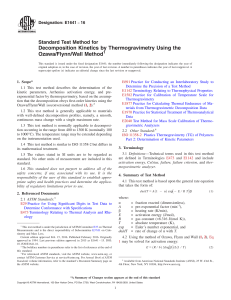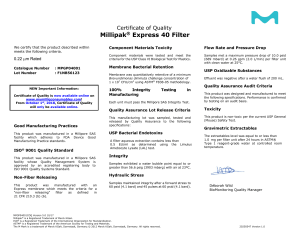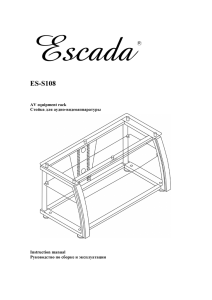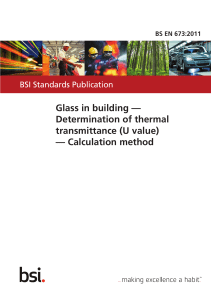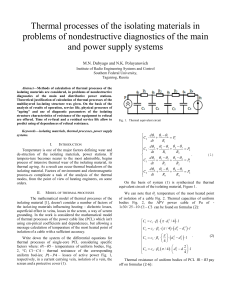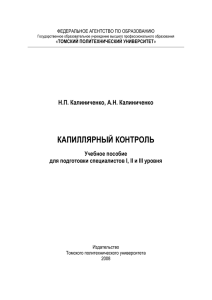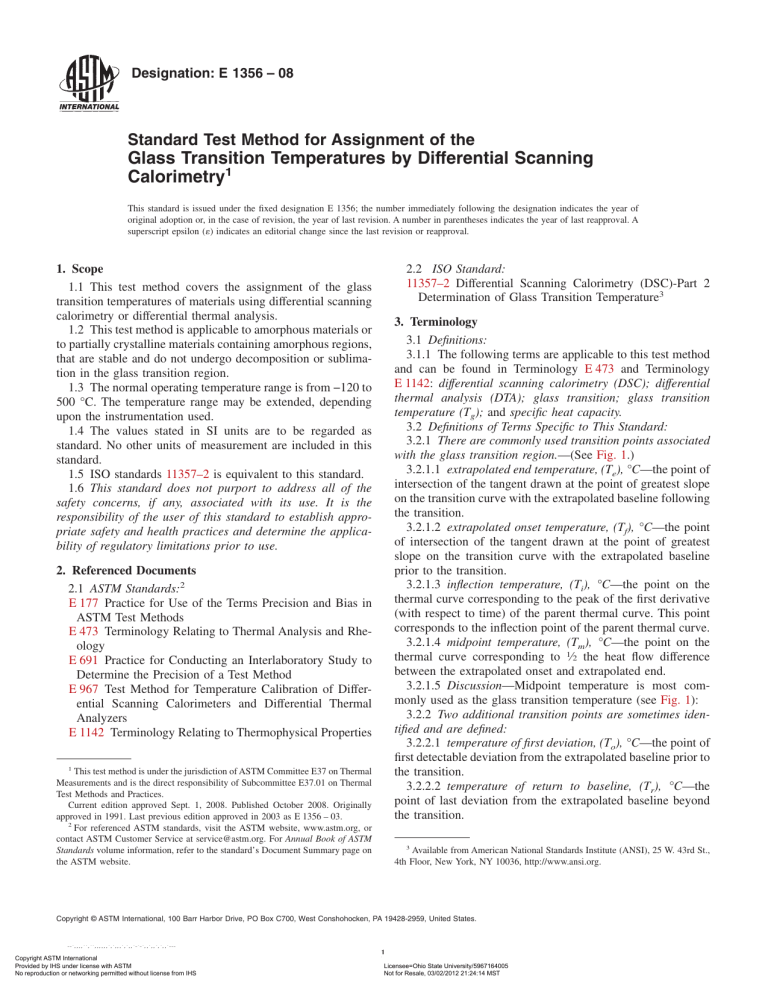
Designation: E 1356 – 08 Standard Test Method for Assignment of the Glass Transition Temperatures by Differential Scanning Calorimetry1 This standard is issued under the fixed designation E 1356; the number immediately following the designation indicates the year of original adoption or, in the case of revision, the year of last revision. A number in parentheses indicates the year of last reapproval. A superscript epsilon (´) indicates an editorial change since the last revision or reapproval. 2.2 ISO Standard: 11357–2 Differential Scanning Calorimetry (DSC)-Part 2 Determination of Glass Transition Temperature3 1. Scope 1.1 This test method covers the assignment of the glass transition temperatures of materials using differential scanning calorimetry or differential thermal analysis. 1.2 This test method is applicable to amorphous materials or to partially crystalline materials containing amorphous regions, that are stable and do not undergo decomposition or sublimation in the glass transition region. 1.3 The normal operating temperature range is from −120 to 500 °C. The temperature range may be extended, depending upon the instrumentation used. 1.4 The values stated in SI units are to be regarded as standard. No other units of measurement are included in this standard. 1.5 ISO standards 11357–2 is equivalent to this standard. 1.6 This standard does not purport to address all of the safety concerns, if any, associated with its use. It is the responsibility of the user of this standard to establish appropriate safety and health practices and determine the applicability of regulatory limitations prior to use. 3. Terminology 3.1 Definitions: 3.1.1 The following terms are applicable to this test method and can be found in Terminology E 473 and Terminology E 1142: differential scanning calorimetry (DSC); differential thermal analysis (DTA); glass transition; glass transition temperature (Tg); and specific heat capacity. 3.2 Definitions of Terms Specific to This Standard: 3.2.1 There are commonly used transition points associated with the glass transition region.—(See Fig. 1.) 3.2.1.1 extrapolated end temperature, (Te), °C—the point of intersection of the tangent drawn at the point of greatest slope on the transition curve with the extrapolated baseline following the transition. 3.2.1.2 extrapolated onset temperature, (Tf), °C—the point of intersection of the tangent drawn at the point of greatest slope on the transition curve with the extrapolated baseline prior to the transition. 3.2.1.3 inflection temperature, (Ti), °C—the point on the thermal curve corresponding to the peak of the first derivative (with respect to time) of the parent thermal curve. This point corresponds to the inflection point of the parent thermal curve. 3.2.1.4 midpoint temperature, (Tm), °C—the point on the thermal curve corresponding to 1⁄2 the heat flow difference between the extrapolated onset and extrapolated end. 3.2.1.5 Discussion—Midpoint temperature is most commonly used as the glass transition temperature (see Fig. 1): 3.2.2 Two additional transition points are sometimes identified and are defined: 3.2.2.1 temperature of first deviation, (To), °C—the point of first detectable deviation from the extrapolated baseline prior to the transition. 3.2.2.2 temperature of return to baseline, (Tr), °C—the point of last deviation from the extrapolated baseline beyond the transition. 2. Referenced Documents 2.1 ASTM Standards:2 E 177 Practice for Use of the Terms Precision and Bias in ASTM Test Methods E 473 Terminology Relating to Thermal Analysis and Rheology E 691 Practice for Conducting an Interlaboratory Study to Determine the Precision of a Test Method E 967 Test Method for Temperature Calibration of Differential Scanning Calorimeters and Differential Thermal Analyzers E 1142 Terminology Relating to Thermophysical Properties 1 This test method is under the jurisdiction of ASTM Committee E37 on Thermal Measurements and is the direct responsibility of Subcommittee E37.01 on Thermal Test Methods and Practices. Current edition approved Sept. 1, 2008. Published October 2008. Originally approved in 1991. Last previous edition approved in 2003 as E 1356 – 03. 2 For referenced ASTM standards, visit the ASTM website, www.astm.org, or contact ASTM Customer Service at service@astm.org. For Annual Book of ASTM Standards volume information, refer to the standard’s Document Summary page on the ASTM website. 3 Available from American National Standards Institute (ANSI), 25 W. 43rd St., 4th Floor, New York, NY 10036, http://www.ansi.org. Copyright © ASTM International, 100 Barr Harbor Drive, PO Box C700, West Conshohocken, PA 19428-2959, United States. --`,,,,``,``,,,,,,`,`,,,`,`,,`-`-`,,`,,`,`,,`--- Copyright ASTM International Provided by IHS under license with ASTM No reproduction or networking permitted without license from IHS 1 Licensee=Ohio State University/5967164005 Not for Resale, 03/02/2012 21:24:14 MST E 1356 – 08 FIG. 1 Glass Transition Region Measured Temperatures some materials degrade near the glass transition region, care must be taken to distinguish between degradation and glass transition. 6.3 Since milligram quantities of sample are used, it is essential to ensure that specimens are homogeneous and representative, so that appropriate sampling techniques are used. 4. Summary of Test Method 4.1 This test method involves continuously monitoring the difference in heat flow into, or temperature between a reference material and a test material when they are heated or cooled at a controlled rate through the glass transition region of the test material and analyzing the resultant thermal curve to provide the glass transition temperature. 5. Significance and Use 5.1 Differential scanning calorimetry provides a rapid test method for determining changes in specific heat capacity in a homogeneous material. The glass transition is manifested as a step change in specific heat capacity. For amorphous and semicrystalline materials the determination of the glass transition temperature may lead to important information about their thermal history, processing conditions, stability, progress of chemical reactions, and mechanical and electrical behavior. 5.2 This test method is useful for research, quality control, and specification acceptance. 7. Apparatus 7.1 Differential Scanning Calorimeter, The essential instrumentation required to provide the minimum differential scanning calorimetric capability for this method includes a Test Chamber composed of a furnace(s) to provide uniform controlled heating (cooling) of a specimen and reference to a constant temperature or at a constant rate over the temperature range from –120 to 500 °C, a temperature sensor to provide an indication of the specimen temperature to 60.1 °C, differential sensors to detect heat flow difference between the specimen and reference with a sensitivity of 6 µW, a means of sustaining a test chamber environment of a purge gas of 10 to 100 mL/min within 4 mL/min, a Temperature Controller, capable of executing a specific temperature program by operating the furnace(s) between selected temperature limits at a rate of temperature change of up to 20 °C/min constant to 6 0.5 °C/ min. 7.2 A Data Collection Device, To provide a means of acquiring, storing, and displaying measured or calculated signals, or both. The minimum output signals required for DSC are heat flow, temperature and time. Copyright ASTM International Provided by IHS under license with ASTM No reproduction or networking permitted without license from IHS --`,,,,``,``,,,,,,`,`,,,`,`,,`-`-`,,`,,`,`,,`--- 6. Interferences 6.1 A change in heating rates and cooling rates can affect the results. The presence of impurities will affect the transition, particularly if an impurity tends to plasticize or form solid solutions, or is miscible in the post-transition phase. If particle size has an effect upon the detected transition temperature, the specimens to be compared should be of the same particle size. 6.2 In some cases the specimen may react with air during the temperature program causing an incorrect transition to be measured. Whenever this effect may be present, the test shall be run under either vacuum or an inert gas atmosphere. Since 2 Licensee=Ohio State University/5967164005 Not for Resale, 03/02/2012 21:24:14 MST E 1356 – 08 7.3 Containers, (pans, crucibles, vials, etc.) that are inert to the specimen and reference materials and that are of suitable structural shape and integrity to contain the specimen and references. 7.4 For ease of interpretation, an inert reference material with an heat capacity approximately equivalent to that of the specimen may be used. The inert reference material may often be an empty specimen capsule or tube. 7.5 Nitrogen, or other inert purge gas supply, of purity equal to or greater than 99.9 %. 7.6 Analytical Balance, with a capacity greater than 100 mg, capable of weighing to the nearest 0.01 mg. where: Tig = inflection temperature, °C Tf = extrapolated onset temperature, °C, and Tm = midpoint temperature, °C. Increasing the heating rate produces greater baseline shifts thereby improving detectability. In the case of DSC the signal is directly proportional to the heating rate in heat capacity measurements. NOTE 2—The glass transition takes place over a temperature range and is known to be affected by time dependent phenomena, such as the rate of heating (cooling). For these reasons, the establishment of a single number for the glass transition needs some explanation. Either Tf or Tm or Ti may be selected to represent the temperature range over which the glass transition takes place. The particular temperature chosen must be agreed on by all parties concerned. In selecting which value should be taken as Tg, the reader may wish to consider the following: (a) Tm was found to have higher precision than Tf (see 12.3). (b) The measurement of Tf is often easier for those who construct the respective tangents by hand. (c) Tm (preferred) or Ti is more likely to agree with the measurement of Tg by other techniques since it is constructed closer to the middle of the temperature range over which the glass transition occurs. (d) Tf may be taken to more closely represent the onset of the temperature range over which the glass transition occurs. Any comparison of glass transition temperatures should contain a statement of how the test was run and how the value was obtained. --`,,,,``,``,,,,,,`,`,,,`,`,,`-`-`,,`,,`,`,,`--- 8. Specimen Preparation 8.1 Powders or Granules—Avoid grinding if a preliminary thermal cycle as outlined in 10.2 is not performed. Grinding or similar techniques for size reduction often introduce thermal effects because of friction or orientation, or both, and thereby change the thermal history of the specimen. 8.2 Molded Parts or Pellets—Cut the samples with a microtome, razor blade, paper punch, or cork borer (size No. 2 or 3) to appropriate size in thickness or diameter, and length that will approximate the desired mass in the subsequent procedure. 8.3 Films or Sheets—For films thicker than 40 µm, see 8.2. For thinner films, cut slivers to fit in the specimen tubes or punch disks, if circular specimen pans are used. 8.4 Report any mechanical or thermal pretreatment. 10.8 Recheck the specimen mass to ensure that no loss or decomposition has occurred during the measurement. 11. Report 11.1 Report the following information: 11.1.1 A complete identification and description of the material tested. 11.1.2 Description of instrument used for the test. 11.1.3 Statement of the dimensions, geometry, and material of the specimen holder. 11.1.4 The scan rate in °C/min. 11.1.5 Description of temperature calibration procedure. 11.1.6 Identification of the specimen environment by pressure, gas flow rate, purity and composition, including humidity, if applicable. 11.1.7 Results of the transition measurements using temperature parameters (Tg, etc.) cited in Fig. 1, or any combination of parameters that were chosen. 11.1.8 Tg (half extrapolated heat capacity temperature) is preferred. 11.1.9 Any side reactions (for example, crosslinking, thermal degradation, oxidation) shall also be reported and the reaction identified, if possible. 9. Calibration 9.1 Using the same heating rate, purge gas, and flow rate as that to be used for analyzing the specimen, calibrate the temperature axis of the instrument following the procedure given in Practice E 967. 10. Procedure 10.1 Use a specimen mass appropriate for the material to be tested. In most cases a 5 to 20 mg mass is satisfactory. An amount of reference material with a heat capacity closely matched to that of the specimen may be used. An empty specimen pan may also be adequate. 10.2 If appropriate, perform and record an initial thermal program in flowing nitrogen or air environment using a heating rate of 10 °C/min to a temperature at least 20 °C above Te to remove any previous thermal history. (See Fig. 1.) NOTE 1—Other, preferably inert, gases may be used, and other heating and cooling rates may be used, but must be reported. 10.3 Hold temperature until an equilibrium as indicated by the instrument response is achieved. 10.4 Program cool at a rate of 20 °C/min to 50 °C below the transition temperature of interest. 10.5 Hold temperature until an equilibrium as indicated by the instrument response is achieved. 10.6 Repeat heating at same rate as in 10.2, and record the heating curve until all desired transitions have been completed. Other heating rates may be used but must be reported. 10.7 Determine temperatures Tm (preferred) Tf, or Ti, (See Fig. 1.) Copyright ASTM International Provided by IHS under license with ASTM No reproduction or networking permitted without license from IHS 12. Precision and Bias4 12.1 Interlaboratory Test Program—An interlaboratory study for the determination of glass transition temperature as indicated by both the midpoint and the extrapolated onset was conducted in 1984. Three polymeric materials were tested; 4 Supporting data have been filed at ASTM International Headquarters and may be obtained by requesting Research Report RR: E37-1012. 3 Licensee=Ohio State University/5967164005 Not for Resale, 03/02/2012 21:24:14 MST E 1356 – 08 polyurethane, polystyrene, and epoxy glass. Each of six participants tested four specimens of each material. (One did not report test data on polyurethane.) Practice E 691 was followed for the design and the analysis of the data. 12.2 Test Result—The precision information given below in Celsius degrees is for the comparison of two test results, each of which is a single determination. 12.3 Precision: DSC Determination of Tg:TmData Tf, °C Polyurethane Polystyrene Epoxy Glass 4.5 103.6 118.4 95 % Limit, °C Repeatability Reproducibility 4.59 2.05 3.90 Tm, °C Polyurethane Polystyrene Epoxy Glass 12.2 106.3 123.0 95 % Limit, °C Repeatability Reproducibility 2.24 1.85 2.77 6.53 3.18 6.88 13. Keywords 13.1 differential scanning calorimetry (DSC); differential thermal analysis (DTA); glass transition; specific heat capacity ASTM International takes no position respecting the validity of any patent rights asserted in connection with any item mentioned in this standard. Users of this standard are expressly advised that determination of the validity of any such patent rights, and the risk of infringement of such rights, are entirely their own responsibility. This standard is subject to revision at any time by the responsible technical committee and must be reviewed every five years and if not revised, either reapproved or withdrawn. Your comments are invited either for revision of this standard or for additional standards and should be addressed to ASTM International Headquarters. Your comments will receive careful consideration at a meeting of the responsible technical committee, which you may attend. If you feel that your comments have not received a fair hearing you should make your views known to the ASTM Committee on Standards, at the address shown below. This standard is copyrighted by ASTM International, 100 Barr Harbor Drive, PO Box C700, West Conshohocken, PA 19428-2959, United States. Individual reprints (single or multiple copies) of this standard may be obtained by contacting ASTM at the above address or at 610-832-9585 (phone), 610-832-9555 (fax), or service@astm.org (e-mail); or through the ASTM website (www.astm.org). --`,,,,``,``,,,,,,`,`,,,`,`,,`-`-`,,`,,`,`,,`--- Copyright ASTM International Provided by IHS under license with ASTM No reproduction or networking permitted without license from IHS 4.15 2.02 5.17 The above terms repeatability and reproducibility limit are used as specified in Practice E 177. The respective standard deviations among test results may be obtained by dividing the numbers in the third and fourth columns by 2.8. 12.4 The bias for these measurements is undetermined because there are no reference values available for the materials used. DSC Determination of Tg:TfData Material Material 4 Licensee=Ohio State University/5967164005 Not for Resale, 03/02/2012 21:24:14 MST
